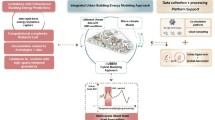Abstract
This work proposes an approach to simulate wind flow fields around an urban environment with the aim of evaluating the potential impact of buildings on the general wind patterns and power production using the current generation of commercial wind turbines. The simulation process was performed with the aid of accessible computational tools that can potentially render the proposed procedure applicable in other cases of interest. The roughness of the urban environment was defined as the association of roughness map, topography, and an alternative process for obtaining the volumetry of buildings. A case study was conducted in a region located at the district of Boa Viagem (Recife-PE) for assessing the applicability of the approach. Scenarios were designed in order to simulate wind flow patterns and pre-identify sites that have suitable wind energy potential for electric power production by investigating the combination of wind speed magnitude and turbulence intensity. From the results obtained, it was possible to identify zones of potential wind sources that are not detected in classical wind atlas probably due to the influence of the built environment on local wind flow patterns.
Similar content being viewed by others
References
Ahrens CD (2008) Essentials of meteorology: an invitation to the atmosphere. Thomson Learning Inc, Belmont
Araújo AM, Melo GM, Medeiros ALR, Santos MJ (2009) Simulación de La Producción de Energía Eléctrica com Aerogeneradores de Pequeño Tamaño. Inf Tecnol 20:37–44. doi:10.4067/s0718-07642009000300006. On-line version ISSN 0718-0764
Britter RE, Hanna SR (2003) Flow and dispersion in urban areas. Annu Rev Fluid Mech 35: 469–96. doi:10.1146/annurev.fluid.35.101101.161147
Burian, SJ, Stetson SW, Han WS, Ching JKS, and Byun DW (2004) High-resolution dataset of urban canopy parameters for Houston, Texas. Preprints, Fifth conference on the urban environment, Vancouver, BC, Canada, American Meteorological Society, 9.3. Online. http://ams.confex.com/ams/AFAPURBBIO/techprogram/paper_80263.hm
Cheremisinoff NP (2002) Handbook of air pollution prevention and control. Butterworth-Heinemann, Woburn
Ching J, Brown M, Burian S, Chen F, Cionco R, Hanna A, Hultgren T, McPherson T, Sailor D, Taha H, Williams D (2009) National urban database and access portal tool. American Meteorological Society. doi:10.1175/2009BAMS2675.1
Cionco RM, Ellefsen R (1998) High resolution urban morphology data for urban wind flow modeling. Atmos Environ 32(1): 7–17
Dayan E (2006) Wind energy in buildings: power generation from wind in the urban environment—where it is needed most. Urban Environ 7(2). doi:10.1016/S1471-0846(06)70545-5
Fact sheet (2007) Division of environment and infrastructure, wind energy—Brazil. http://www.gtz.de/de/dokumente/en-windenergy-factsheet-brazil-2007.pdf
Fernando HJS, Lee SM, Anderson J, Princevac M, Pardyjak E, Grossman-Clarke S (2001) Urban fluid mechanics: air circulation and contaminant dispersion in cities. Environ Fluid Mech 1: 107–164. doi:10.1023/A:1011504001479
Global Wind Report (2010) Global Wind Energy Council. http://www.gwec.net
Hang J, Sandberg M, Li Y (2009) Effect of urban morphology on wind condition in idealized city models. Atmos Environ 43: 869–878. doi:10.1016/j.atmosenv.2008.10.040
International Electrotechnical Commission (1998) Wind Turbine Generator Systems. IEC 61400-12, Geneva
Khan IM, Simons RR, Grass AJ (2005) Upstream turbulence effect on pollution dispersion. Environ Fluid Mech 5: 393–413. doi:10.1007/s10652-005-2932-7
Kozmar H (2011) Wind-tunnel simulations of the suburban ABL and comparison with international standards. Wind Struct 14(1):15–34. http://143.248.120.142/samplejournal/pdf/was1401002.pdf. Accessed 15 Apr 2012
Lafargea F et al (2008) Automatic building extraction from DEMs using an object approach and application to the 3D-city modeling. ISPRS J Photogram Remote Sensing 63(3): 365–381
Lee SJ, Park CW, Kang JH, Daichin (2009) Evaluation of wind environment around a residential complex using a PIV velocity field measurement technique. Environ Fluid Mech 9: 655–668. doi:10.1007/s10652-009-9133-8
Lia XX, Liub CH, Leunga YCD, Lam KM (2006) Recent progress in CFD modelling of wind field and pollutant transport in street canyons. Atmos Environ 5640–5658. doi:10.1016/j.atmosenv.2006.04.055
Lopes AMG (2003) Windstation—a software for the simulation of atmospheric flows over complex topography. Environ Model Softw 18: 81–96
Lu L, Ip KY (2007) Investigation on the feasibility and enhancement methods of wind power utilization in high-rise buildings of Hong Kong. Renew Sustain Energy Rev 13(2). doi:10.1016/j.rser.2007.11.013
Mertens S (2003) The energy yield of roof mounted wind turbines. Wind Eng 27(6): 507–518
Mertens S (2006) Wind energy in the built environment. Multi-Science Publishing Co. Ltd., Essex
Ratti C, Sabastiano SD, Britter R, Brown M, Caton F, Burian S (2002) Analysis of 3-D urban database with respect to pollution dispersion for a number of European and American cities. Water Air Soil Pollut 2: 459–469
Rohatgi JS (1994) Wind characteristics: an analysis for the generation of wind power. Alternative Energy Institute, West Texas A&M University, Canyon
Taha H (2008) Urban surface modification as a potential ozone air-quality improvement strategy in California: a mesoscale modelling study. Boundary-Layer Meteorol 127: 219–239. doi:10.1007/s10546-007-9259-5
Tonga H, Walton A, Sang J, Chan CLJ (2005) Numerical simulation of the urban boundary layer over the complex terrain of Hong Kong. Atmos Environ 3549–3563. doi:10.1016/j.atmosenv.2005.02.045
Valença DAA (2010) Proposição de uma Metodologia Para a Avaliação do Aproveitamento da Energia Eólica em Ambiente Urbano. M.Sc. Dissertation, Federal University of Pernambuco
Author information
Authors and Affiliations
Corresponding author
Rights and permissions
About this article
Cite this article
Araújo, A.M., de Alencar Valença, D.A., Asibor, A.I. et al. An approach to simulate wind fields around an urban environment for wind energy application. Environ Fluid Mech 13, 33–50 (2013). https://doi.org/10.1007/s10652-012-9258-z
Received:
Accepted:
Published:
Issue Date:
DOI: https://doi.org/10.1007/s10652-012-9258-z




